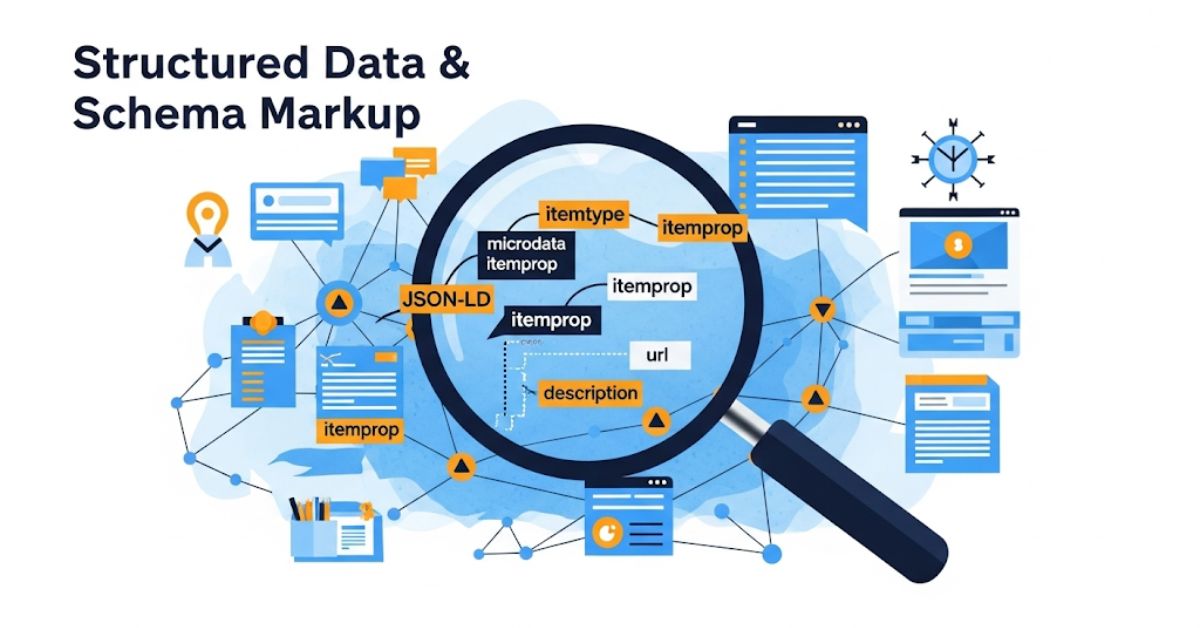In today’s digital world, getting your content noticed is harder than ever. With so much information available online, search engines like Google, Bing, and even AI-based tools such as ChatGPT or voice assistants must filter the best answers to show users. This is where Answer Engine Optimization (AEO) comes in.
AEO focuses on making your content easily understandable and accessible to search engines so they can use it to answer users’ questions directly. One of the most powerful tools that helps achieve this is structured data through schema markup. These elements work behind the scenes to tell search engines exactly what your content is about, so it can be shown in featured snippets, voice search results, knowledge panels, and more.
In this article, we’ll explore structured data and schema markup in detail, explain how they boost AEO, and guide you on how to use them correctly for better online visibility.
What Is Structured Data?
Structured data is a way to organize information on a web page so that search engines can easily understand it. Think of it as a way of labeling your content so that machines can process it more accurately.
Example:
- Unstructured data: “John Smith is a lawyer in New York with 10 years of experience.”
- Structured data:
{ “@context”: “https://schema.org”,
“@type”: “Person”,
“name”: “John Smith”,
“jobTitle”: “Lawyer”,
“address”: {
“addressLocality”: “New York” },
“experience”: “10 years”}
Structured data does not change what users see, but it changes how search engines interpret the information. It makes the content machine-readable, allowing platforms to display it more effectively in search results.
What Is Schema Markup?
Schema markup is a specific vocabulary used in structured data. It was created through a collaboration between major search engines (Google, Bing, Yahoo, and Yandex) under the organization Schema.org.
Schema markup tells search engines what type of content is on your page: is it a blog post, a product, a recipe, or a business profile?
Formats:
- JSON-LD (JavaScript Object Notation for Linked Data): Most recommended by Google
- Microdata: Embedded directly in HTML
- RDFa: Uses HTML5 tags
Common Schema Types:
- Article: For blogs and news
- Product: For online store items
- FAQPage: For frequently asked questions
- LocalBusiness: For business location and contact
- Review: For customer reviews
Using schema markup, you can provide detailed information about your content and help it stand out in search results.
How Structured Data Powers AEO
AEO is about making your content the best possible answer for a user’s query. Structured data plays a critical role in this by improving how search engines interpret and display your content.
Key Benefits:
- Improves visibility in featured snippets and AI-generated answers
- Enhances voice search performance, as structured content is easier to read aloud
- Increases click-through rates (CTR) because rich results look more attractive
- Supports AI-based engines like Google SGE or Bing AI, which rely on accurate, structured data to serve fast answers
In short, structured data is like giving search engines a cheat sheet for your page. This makes your content more likely to be selected as the “answer” to a query.
Types of Schema Markup That Boost AEO
To improve your website’s chances of showing up in featured snippets, voice search, and AI-generated answers, using the right schema markup is key. Below are some of the most important schema types that help boost Answer Engine Optimization (AEO).
1. FAQPage Schema
This schema is designed for pages that answer frequently asked questions. Each question and its answer are marked up so that search engines like Google can pull and display them directly in search results. This makes your content more interactive and can increase your visibility, especially in mobile and voice searches.
2. HowTo Schema
If your content involves steps to complete a task, like recipes, DIY projects, or tutorials, HowTo schema is the best choice. It helps display step-by-step instructions, sometimes with images and tools required, directly in search results. This structured format makes it easier for users to follow your instructions without clicking through, while still driving traffic and authority to your site.
3. Product and Offer Schema
For e-commerce websites, Product and Offer schema are crucial. They allow search engines to show essential product details like price, availability, brand, ratings, and offers right in the search results. This not only improves click-through rates but also helps products appear in Google Shopping or image-based product carousels.
4. Article and BlogPosting Schema
Used for news articles and blog posts, this schema highlights information such as the headline, author name, publication date, featured image, and publisher. It helps Google understand your content and can increase chances of appearing in Google News or featured snippets.
5. Organization and LocalBusiness Schema
This schema helps search engines identify and display business information like logo, address, phone number, business hours, and social profiles. It’s highly effective for improving brand presence and boosting local SEO.
6. Review and Rating Schema
This schema enables star ratings and customer reviews to show up directly in search listings. It builds trust with users and often improves the click-through rate.
7. VideoObject Schema
When you use VideoObject schema, Google can better understand and showcase your videos in search results, often with thumbnails, durations, and descriptions.
8. Speakable Schema
Especially useful for voice assistants, this schema marks parts of your content that can be spoken aloud by devices like Google Assistant. It supports voice search and improves accessibility.
Implementing Schema Markup: Methods & Tools
There are several ways to add schema markup to your website:
1. JSON-LD (Recommended)
- Easy to implement
- Doesn’t interfere with HTML code
- Google prefers this format
2. WordPress Plugins
- Rank Math and Yoast SEO are popular choices
- Automatically add schema based on post type
- Great for beginners with no coding knowledge
3. Google’s Structured Data Markup Helper
- Lets you tag content manually
- Generates ready-to-use JSON-LD code
4. Manual Coding
- Gives full control
- Useful for advanced users or developers
5. Validation Tools
- Google Rich Results Test
- Schema.org Validator
Make sure to test and validate your markup before going live.
Best Practices for Schema and AEO
To get the best results from schema markup, follow these best practices:
- Choose the correct schema type for each page
- Match schema data with visible content to avoid penalties
- Keep information accurate and up to date
- Avoid overusing schema or faking reviews
- Validate frequently using tools
- Use structured data on all major pages, not just your homepage
- Stay updated with changes from Google and Schema.org
Common Mistakes to Avoid
Many websites use schema markup incorrectly. Avoid these common errors:
- Using the wrong schema type
- Adding schema to irrelevant pages
- Leaving out required properties
- Copying code from other websites without editing
- Failing to update schema when content changes
- Only using schema on blog posts
Mistakes can cause your page to lose visibility in search results or be penalized.
Case Studies & Real-World Impact
Case Study 1: Blog with FAQ Schema
A health blog added FAQ schema to 10 of its posts. Within 3 weeks, 5 of those posts appeared in featured snippets. Organic traffic increased by 28%.
Case Study 2: E-commerce Store with Product Schema
An online clothing brand added Product schema to all product pages. Google started showing price and review ratings in search. Click-through rate improved by 18%, and conversion rate rose by 9%.
Case Study 3: Local Business Using LocalBusiness Schema
A dental clinic implemented LocalBusiness schema. Their business profile started appearing on top in local search, with phone number and directions highlighted. This led to a 22% increase in calls from search.
These examples prove that structured data leads to real, measurable AEO results.
Future of Schema Markup in AEO
As AI continues to grow, structured data will become even more important.
Future Trends:
- AI-generated answers will rely heavily on structured data
- Voice search will favor content with speakable and answer-ready schema
- Visual and semantic search (images + context) will use schema to understand image metadata
- E-E-A-T signals (Experience, Expertise, Authoritativeness, Trustworthiness) may increasingly depend on structured author and organization data
To stay ahead, websites must use schema markup not just for SEO, but as a strategic part of their AEO strategy.
Conclusion
Structured data and schema markup are no longer optional in the world of AEO. As search engines and AI tools evolve, they need more help understanding your content. Schema markup provides that help by making your website content clearer, richer, and easier to use in direct answers, voice searches, and rich results.
Whether you run a blog, a local business, or an online store, using schema markup the right way can dramatically increase your visibility, clicks, and user engagement. Invest time in applying and maintaining structured data, and you’ll be rewarded with better rankings, smarter AI recognition, and a stronger digital presence.



